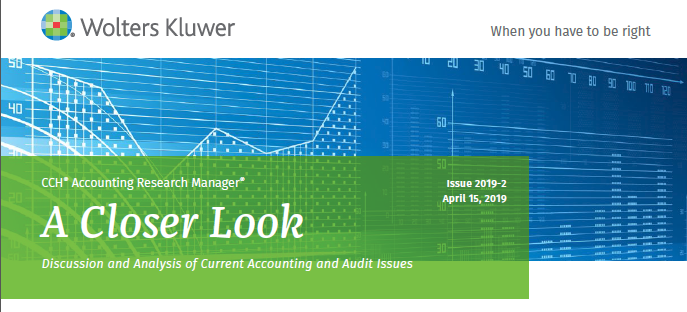
The FASB is making a number of targeted changes to its new standard related to accounting for credit losses on financial instruments known as the Current Expected Credit Loss (CECL) model. CCH Accounting Research Manager has published a new edition of A Closer Look that discusses the recently issued changes, two exposure drafts proposing additional amendments to the rules on measuring credit losses, a recently published FASB Staff Q&A on the topic of estimating expected credit losses, and a recent roundtable discussion on the presentation of loan loss provisions in the income statement.
Extant GAAP and the Financial Instruments Credit Losses Standard as Originally Issued
U.S. GAAP currently requires an “incurred loss” methodology for recognizing credit losses that delays recognition until it is probable a loss has been incurred. Both financial institutions and users of their financial statements expressed concern that this methodology restricted the ability to record credit losses that are expected, but do not yet meet the “probable” threshold. The global financial crisis underscored those concerns because users analyzed credit losses by using forward-looking information to assess an entity’s allowance for credit losses on the basis of their own expectations. In the lead-up to the financial crisis, financial statement users were making estimates of expected credit losses and devaluing financial institutions before accounting losses were recognized, highlighting the differing information needs of users from what was required by U.S. GAAP. Similarly, financial institutions expressed frustration during this period because they could not record credit losses that they were expecting but had not yet met the probable threshold.
The FASB’s new standard on credit losses for financial instruments, Accounting Standards Update (ASU) No. 2016-13, Financial Instruments – Credit Losses (Topic 326), significantly changes the measurement and recognition of losses on financial assets such as loans and trade receivables. That new standard (referred to herein as Topic 326) becomes effective January 1, 2020 for calendar year-end public companies that file with the SEC. However, it can be early adopted by any company for fiscal years beginning after December 15, 2018. Because the new accounting model is complex and differs substantially from longstanding U.S. GAAP, the FASB has been receiving numerous questions from companies as they begin to apply the new model to their financial assets. While we believe the FASB is unlikely to change the principles in Topic 326 as a result of these questions, the FASB is amending Topic 326 to clarify the new rules and facilitate transition.
Changes Issued
The first amendments to be finalized are contained in ASU No. 2018-19, Codification Improvements to Topic 326, Financial Instruments – Credit Losses, issued in November 2018. This improvements standard addresses the effective date of Topic 326 for private companies and that Topic 326 does not apply to operating lease receivables.
In addition, the FASB Staff released a Q&A in January 2019 regarding the acceptability of a specific method of estimating expected credit losses, referred to as the weighted-average remaining maturity method.
Changes Proposed
Other potential changes are being considered. The FASB has issued two exposure drafts that are expected to be finalized in the next several months. These targeted improvements address a broad range of issues likely to affect many companies that are implementing Topic 326. In addition to conforming amendments that correct for errors and oversights, the proposed topics include guidance related to:
- Accrued interest
- Transfers between classifications or categories for loans and debt securities
- Recoveries
- Reinsurance receivables
- Projections of interest rate environments for variable-rate financial instruments
- Effect of prepayments in determining the effective interest rate
- Estimated costs to sell when foreclosure is probable
- Contractual extensions
- Transition relief – Fair Value option
Looking Forward
There exists a great of deal what could be aptly described as acrimony surrounding the FASB’s CECL model as originally issued. In response the FASB is listening and has issued a number of targeted changes to the requirements. With the public company effective date for Topic 326 less than a year away, it seems two thing are unlikely to change: 1) The new accounting requirements will affect far more entities than just depository and lending institutions, and 2) there will likely be more changes to the guidance.
Login to keep reading on CCH® Accounting Research Manager.
Not a subscriber? Sign up for a Free Trial
Leave a Reply